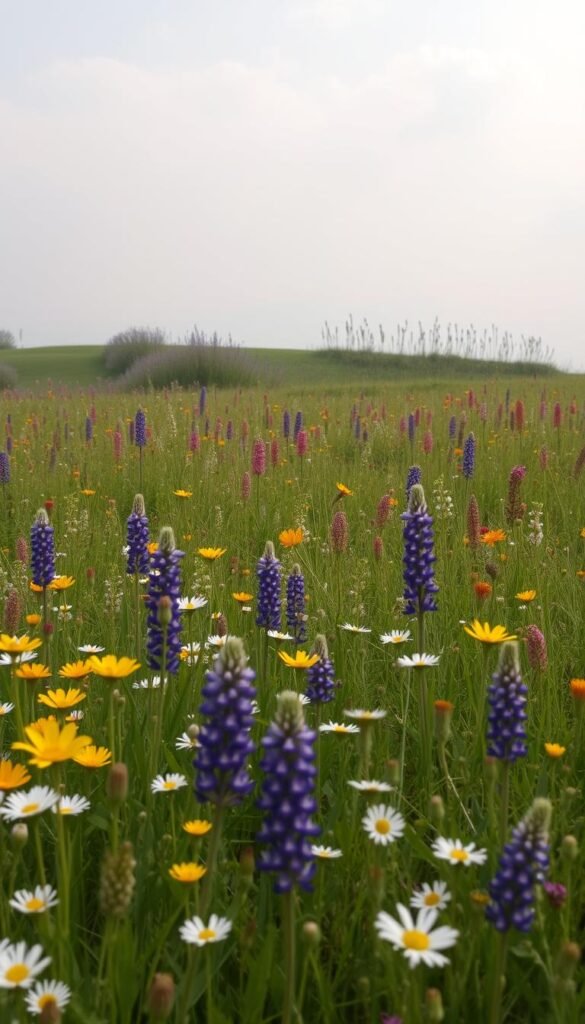Imagine stepping into a vibrant space buzzing with life, where colorful blooms sway in the breeze and butterflies dance between stems. By rethinking your yard, you can create a thriving ecosystem that supports struggling pollinators while adding dynamic beauty to your property. This approach offers more than visual appeal—it’s a practical way to nurture local biodiversity.
Native bees and butterflies face habitat loss nationwide, but your outdoor area can become their sanctuary. Unlike high-maintenance lawns, naturalized spaces require less water and mowing. They also filter rainwater, capture carbon, and build healthier soil over time. These benefits extend beyond your fence line, helping entire communities of plants and animals flourish.
You’ll learn how to design a resilient habitat that mirrors nature’s patterns. We’ll break down plant selection, site preparation, and seasonal care into manageable steps. Discover how native species attract specific pollinators while outcompeting weeds naturally. Even small patches make a difference, providing critical food sources and nesting sites for winged visitors.
Ready to trade weekly yardwork for seasonal surprises? This guide reveals how established meadows evolve beautifully year after year. You’ll gain strategies to balance structure with wild charm, creating spaces that feel intentional yet effortlessly alive. Let’s explore how your green thumb can cultivate both beauty and ecological impact.
Understanding the Benefits of Wildflower Meadows for Pollinators
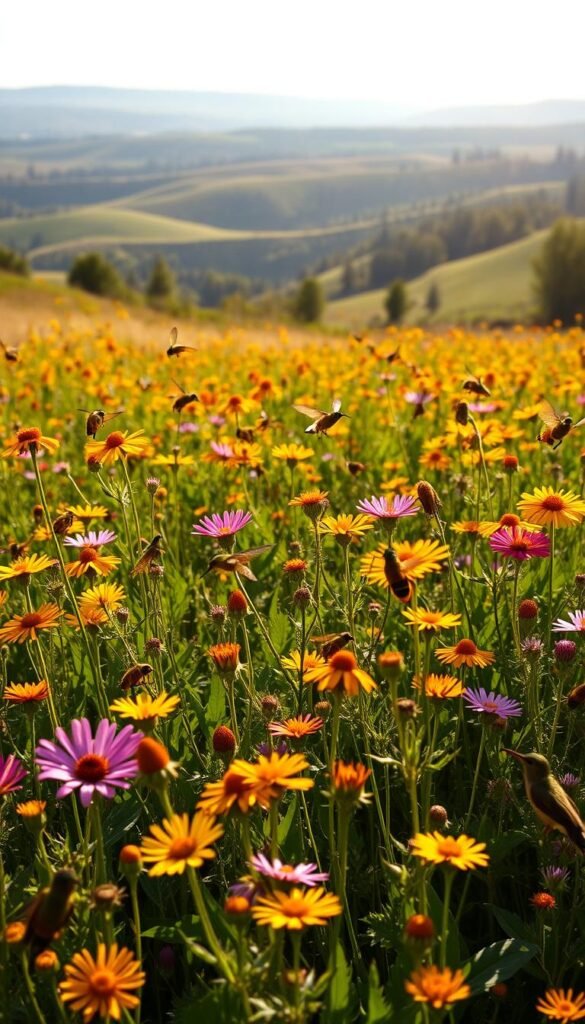
Picture a living tapestry of colors and movement right outside your door. These dynamic spaces do more than dazzle—they sustain life at every level. Let’s explore how they transform your yard into a thriving sanctuary.
Ecosystem Services and Wildlife Habitat
Native plantings act as nature’s multitaskers. Their deep roots stabilize soil during heavy rains, while their dense growth crowds out invasive species. Over 70% of bees nest in undisturbed ground or hollow stems—features naturally found in meadow edges.
These habitats feed more than just pollinators. Birds snack on seeds through winter, while bats hunt moths drawn to evening blooms. Even frogs benefit from the insect buffet, creating a ripple effect across your local wildlife community.
Attracting Bees, Butterflies, and Other Pollinators
Different species need different resources. Monarch butterflies, for example, require milkweed leaves for caterpillars and nectar-rich flowers for adults. By planting diverse natives, you become a one-stop shop for their life cycles.
Here’s what happens when you get it right:
- Solitary bees claim nesting tunnels in dead stems
- Sparrows gather dried seed heads in February
- Fireflies glow above grasses on summer nights
Your choices create year-round food sources and shelter. As these spaces mature, they need less care than traditional lawns—giving you more time to enjoy the show.
Planning Your Wildflower Garden: Site Selection and Preparation
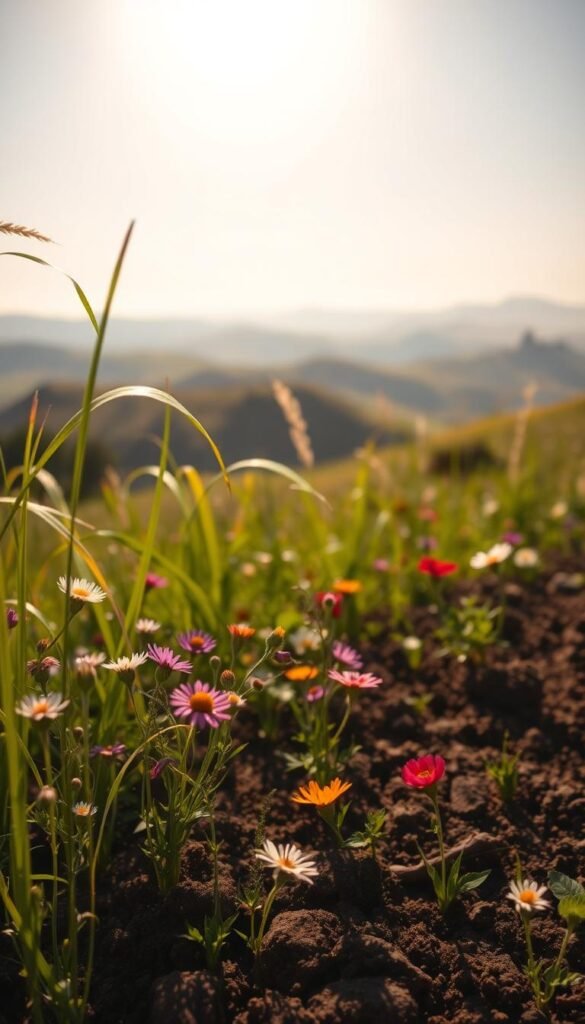
Transform your outdoor space into a thriving habitat by choosing the right location. Proper site selection ensures your plants flourish while creating essential resources for local species.
Light Exposure and Ground Conditions
Start by tracking how sun moves across your yard. Most flowering species need 6+ hours of direct light daily. Use a free app or mark shadows every hour to map bright zones.
Check soil drainage after rainstorms. Puddles lasting over 4 hours signal poor conditions. For quick testing:
- Dig a 6-inch hole
- Fill with water
- Time how long it drains
Native species often prefer unfertilized earth. A simple pH test kit ($12 online) reveals if your soil matches their needs.
Strategic Location Choices
Look for underused areas that meet light requirements. Sunny slopes prevent waterlogging, while curbside strips make eye-catching displays. Even a 10×40 ft area supports diverse growth.
| Site Type | Sun Exposure | Best For |
|---|---|---|
| South-facing slope | Full day | Drought-tolerant species |
| Lawn edge | Morning light | Shade-tolerant blooms |
| Rain garden | Variable | Moisture-loving plants |
Keep pathways clear for maintenance access. Position viewing benches upwind so fragrances drift toward seating areas. For more tips on supporting local species through native plant gardening, explore our detailed guide.
Preparing Your Soil and Eliminating Competition

Your meadow’s success starts beneath the surface. Before sowing a single seed, you’ll need to outsmart stubborn plants that could choke your new growth. This groundwork ensures your future blooms won’t battle aggressive neighbors for nutrients and space.
Organic Weed Control and Smothering Techniques
Smothering unwanted plants creates a clean slate naturally. Cover your ground with 4-6 mil black plastic from mid-June to mid-September. This method blocks sunlight, starving grasses and perennial weeds of energy. Secure edges with rocks or soil to prevent light leaks.
Why does this work so well? Many invasive species store energy in deep roots. By denying them photosynthesis for 12+ weeks, you exhaust their reserves completely. This approach avoids chemical-free gardening practices while protecting soil microbes.
| Material | Coverage Time | Effectiveness |
|---|---|---|
| Black plastic | 3 months | 95% weed elimination |
| Cardboard + mulch | 6 months | 85% suppression |
| Landscape fabric | 2 years | 90% control |
Alternative options like layered cardboard with wood chips work slower but improve soil structure. Whichever you choose, resist digging—disturbance awakens dormant weed seeds. Patience pays off: one season of site preparation means years of easier maintenance.
Remember, perennial grasses regrow from tiny root fragments. Complete light exclusion during site preparation ensures they won’t rebound. By fall, you’ll have friable earth ready for seeding—no hidden competitors lurking below.
Choosing the Right Native Plants and Seed Mixes
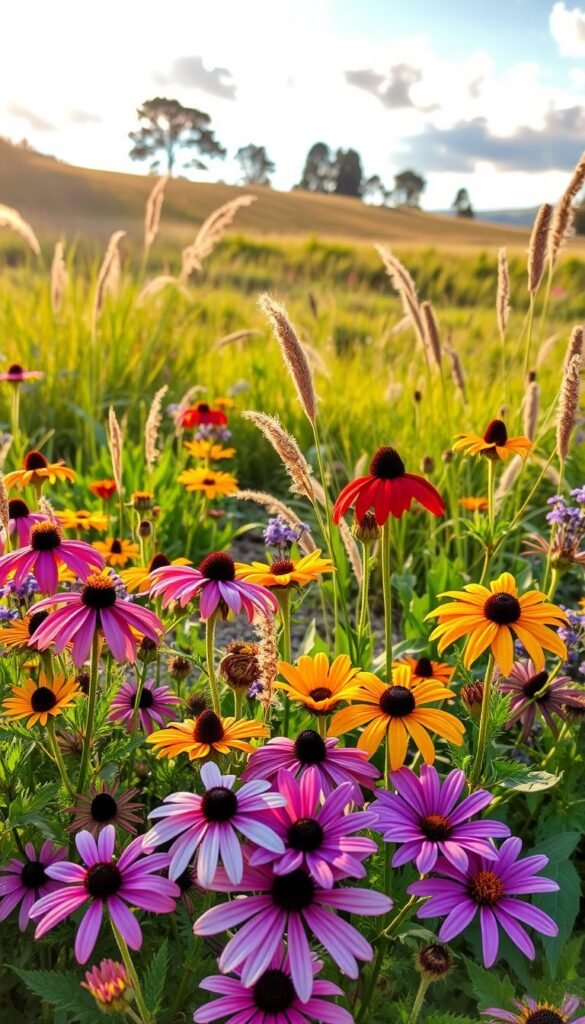
Your meadow’s future hinges on smart seed selection. With countless options available, focus on blends that mirror your region’s natural rhythms while supporting local ecosystems.
Perennials vs. Annuals for a Sustainable Meadow
Annuals might tempt you with quick color, but they’re fleeting guests. Perennial species form the backbone of lasting habitats, returning stronger each year. Their deep roots stabilize soil and survive harsh winters—a must for New England’s climate.
See how they compare:
| Feature | Perennials | Annuals |
|---|---|---|
| Lifespan | 3+ years | 1 season |
| Maintenance | Low after establishment | High reseeding needs |
| Cost Efficiency | Higher initial, lower long-term | Recurring yearly costs |
Choose plants like purple coneflower and black-eyed Susan that thrive in your zone. Pair them with native grasses like little bluestem for structure and shelter.
Customizing Your Seed Mix for the Local Environment
Pre-made mixes often include filler seeds that won’t flourish in your area. Build your own blend using 12+ flowering species with staggered bloom times. This creates a buffet for pollinators from April frosts to October frosts.
Three rules for success:
- Verify each plant’s origin—look for New England ecotypes
- Include 20% native grasses to crowd out weeds
- Avoid “aggressive spreaders” that dominate space
Local nurseries and beginner-friendly blooms often stock regional seeds. Ask suppliers for mixes containing milkweed for monarchs and goldenrod for late-season bees. Your customized mix becomes a living legacy that grows richer with time.
Step-by-Step Guide to Planting Your Meadow
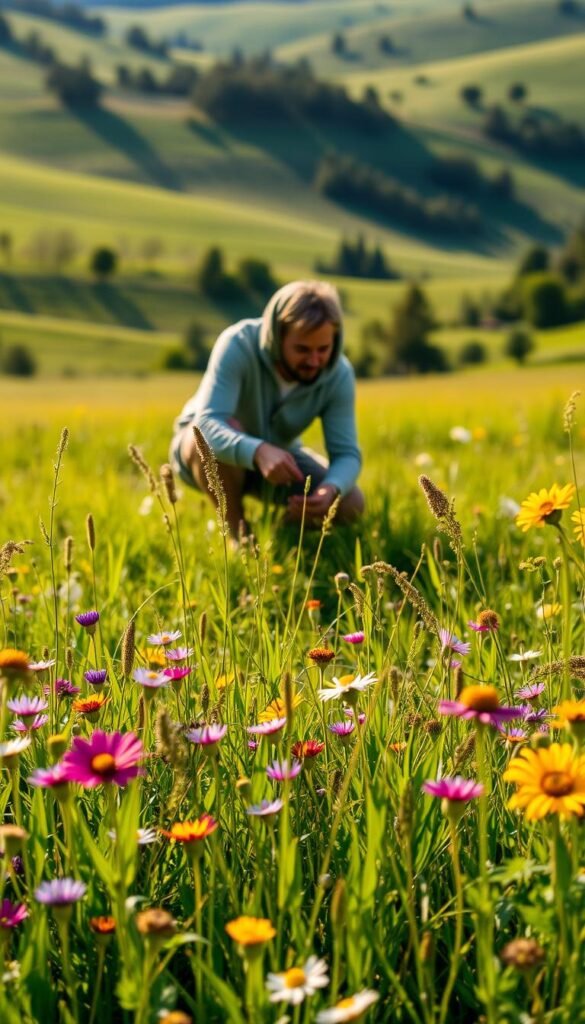
Now comes the exciting part—transforming prepared earth into a living canvas. Let’s walk through the practical steps to ensure your efforts yield lush growth and buzzing activity.
Broadcasting Seeds and Proper Spacing
Think of seed distribution like seasoning a dish—even coverage matters. For areas under 5,000 sq ft, hand broadcasting works best. Mix your seeds with dry vermiculite (4:1 ratio) to boost volume. Gradually add water until the blend clumps slightly, helping tiny seeds stick to particles.
Use this simple method:
- Divide your space into 10×10 ft sections
- Walk north-south spreading half the mix
- Repeat east-west with remaining blend
This crosshatch pattern prevents bare spots. Gently press seeds into the surface with a lawn roller or board—no deeper than ¼ inch.
Seasonal Timing for Planting Success
Nature’s freezer works magic on dormant seeds. In northern states, aim for October-November plantings. Cold stratification breaks dormancy, while winter moisture settles seeds into soil crevices.
| Planting Window | Advantage | Germination Rate |
|---|---|---|
| Late September | Prevents weed competition | 65% |
| Mid-October | Optimal cold exposure | 85% |
| Early December | Natural snow cover | 70% |
Budget $60-80 per 1,000 sq ft for quality mixes. At 0.5 lbs per 1,000 sq ft, you’ll achieve 5-7 plants per square foot—enough for density without overcrowding. Remember: Patience pays off. Your first year focuses on root development, with blooms exploding in year two.
Wild Flower Garden Landscaping: Naturalizing Meadows for Pollinators
Crafting an eco-conscious space starts with smart choices that benefit both nature and your schedule. Once established, these vibrant areas thrive without synthetic inputs, saving water and reducing maintenance. The key lies in balancing native grasses (60-65%) with flowering plants (35-40%)—a formula that supports wildlife while keeping weeds at bay.
Implementing Sustainable and Eco-Friendly Practices
Ditch the chemicals and let nature handle the heavy lifting. Mature plantings need no fertilizers and survive on rainfall alone. Their deep roots prevent erosion better than any lawn, while dormant stems shelter overwintering insects. You’ll spend less time mowing and more time observing dragonflies or hummingbirds.
Enhancing Pollinator Habitat with Native Choices
Local plants evolved alongside regional wildlife, offering perfect food and shelter matches. Goldenrod fuels fall migrations, while milkweed supports monarch caterpillars. For more tips on creating a pollinator haven, explore our guide. Cluster species in groups of three to five—this helps bees spot blooms faster and conserves their energy.
Your meadow becomes a living classroom, teaching resilience through every season. As native roots intertwine, they build a self-repairing tapestry that outcompetes weeds naturally. The result? A thriving habitat that grows lovelier each year while giving back to the earth.

